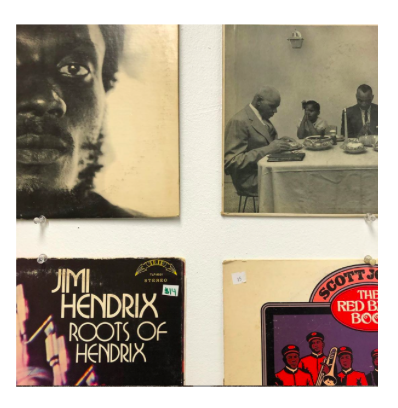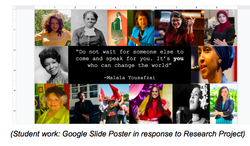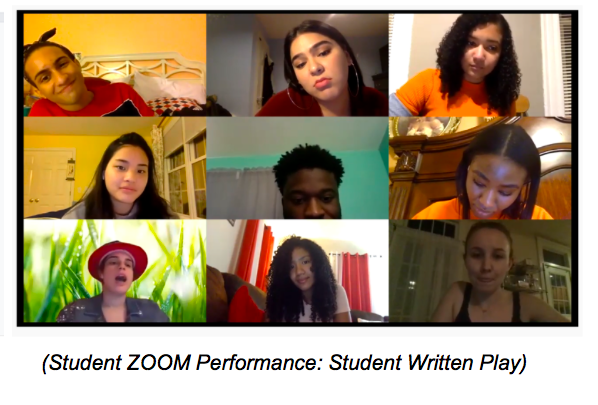As secondary educators and parents, there are a number of questions on our mind as we seek to find creative, relevant and authentic learning experiences for adolescents throughout school closures.
- How are teens making meaning of their lives during the pandemic?
- What is capturing their attention and how are they responding to this dramatic shift in how they are living their lives?
In order to engage the unique voices of our young people, we reimagined a structure that gives teens choice and voice over how they respond to and express themselves at this moment in time.

Step 1: Choose a text, image or video. What captures your attention or interest?
Note: We define “texts” as: anything you can interact with (book, image, film, digital text, object, or any form of media.)
Based on our work with teachers and students in middle and high schools, including conversations with teens about the kinds of “texts” that they spent time thinking about and interacting with, we found that short evocative texts, images, or videos draw the most engagement right now.
We suggest providing teens with choice over what they respond to, and to invite students to find their own “texts” that have the most meaning and relevance to them. Teachers or parents can share their choices first. We shared “texts” with each other that provoked or inspired us over the past six weeks. For example, we chose this poem written by Nikki Giovanni because it inspired us to reframe the constraints of isolation at this time, opening up new possibilities for what we can control right now, specifically with our own mindset and perspective.
“Choices” by Nikki Giovanni
if I can’t do
what i want to do
then my job is to not
do what i don’t want
to do
It’s not the same thing
but it’s the best i can
do
If i can’t have
what i want… then
my job is to want
what i’ve got
and be satisfied
that at least there
is something more to want
Since i can’t go
where i need
to go… then i must… go
where the signs point
though always understanding
parallel movement
isn’t lateral
When i can’t express
what i really feel
i practice feeling
what i can express
and none of it is equal
I know
but that’s why mankind
alone among the animals
learns to cry
Step 2: Make meaning together: How do we create opportunities for teens to express their ideas and collaborate with peers?
After teens choose something meaningful to respond to, the next step is to invite them to make meaning within a collaborative context.
There are many benefits to asking students to write, talk, and share ideas together before they create their response. Students will gain a deeper understanding of the “text” by sharing their initial thinking about it: Why did they choose it? What does it mean to them?
One suggestion is to use a discussion protocol like Save the Last Word for Me. Using this protocol, students can share their text, image or video in a Zoom breakout session with three other peers, each peer can respond to the “text” by sharing their own thoughts, questions, and ideas, and then student presenting can have “the last word” by explaining why they chose the “text” and what is significant about it.
Whether you use the suggested protocol or not, think about a structure that will support the purpose for the conversation: a deeper understanding about their choices. Then, when students go to the next step to develop a response, they will have more insight into their own renewed understanding of the text.
Step 3: Express an idea: How are you going to share your idea, story, perspective, or expression about life at this moment in time? (words, photographs, video, poetry, narrative, music, drama, visual arts, storytelling, etc.)
 Lastly, students can express their developed understanding through a creative medium. For example, we decided to respond to the poem Choices by bringing together a series of images that we personally photographed and painted. We individually created images in response to the poem. Then, together, we selected the images we wanted to include in a collaborative piece and created a virtual quilt.
Lastly, students can express their developed understanding through a creative medium. For example, we decided to respond to the poem Choices by bringing together a series of images that we personally photographed and painted. We individually created images in response to the poem. Then, together, we selected the images we wanted to include in a collaborative piece and created a virtual quilt.
Our choices reflected our passions, interests, mindsets, and perspectives in connection to how we use our time, what we appreciate in our homes and natural world, and the way we experience the constraints of social isolation and connectivity.

Step 4: Choose a Platform to Share Your Creation
What platforms can you use (Tik Tok, Google Slides, Instagram, FlipGrid … give them some choice)?
Sharing what you create with other people is powerful because it gives you the opportunity to connect, respond, and learn about other ways of coping with the pandemic. Each individual voice can impact a collective voice. Teens can think about purposefully choosing a platform that connects their message to the audience that matters to them. We chose Instagram as our platform because we wanted to use images to convey our ideas.







